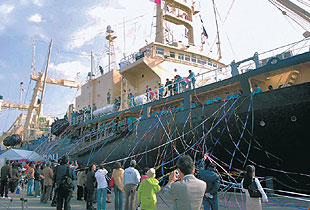ISANA Dec. 2005 No.32
index
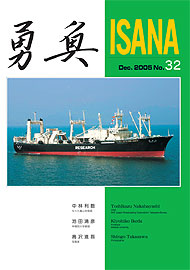
ISANA Dec. 2005 No.32
The Takayama Festival and Whale Baleen

Chief
NHK (Japan Broadcasting Corporation) Takayama Bureau
Gifu is a land-locked prefecture, and Takayama City is located further into the mountains. At first glance, Takayama does not seem to have any relationship to the sea. But actually it does as I will elaborate in this article.
The Takayama Festival, celebrated in spring and autumn, is one of Japan's national tangible folklore cultural properties. The stage (yatai), called a moving Yomei Gate after the famous gate in Nikko, embodies the traditional culture of Hida. Look, for example, at the sculpture of a rooster in one part of two or three stages, and you will find a rooster in a cage carved in one piece of wood. It is not a mere combination of a cage and a rooster carved separately.
The brilliant skill of the craftsmen of Hida, cultivated over a long period of time, is observed in every part of the work. This case serves as a criterion for all the rest. Karakuri (mechanical) puppet plays performed on a stage are also superb.
Unfortunately, there exist only four stages now on which karakuri puppet plays can be performed. Each puppet, the pride of craftsmen, is maneuvered using many strings. But the puppets engaging in drastic movements tend to wear out when used for years, and they are in need of repair from time to time. It is relatively easy to fix wooden parts or clothing, but the most difficult part is the spring. The neck, hands and legs of a puppet engage in subtle movements as they have been doing from olden times. This spring is made of whale baleen. And the best material for the springs is the right whale's baleen. Springs made of steel or plastics cannot reproduce the subtle movements of karakuri puppets handed down from the Edo Period (1603-1868).
I had the chance of joining the 29th Antarctic whaling expedition as a reporter on board the No.3 Nisshin-maru fleet of Taiyo Fishery Co. which left Japan in 1964. I stayed at sea for three and half months. It was the last year when the fleets of Japanese fishing companies set out for whaling in the Antarctic in several. I must add that it was the first opportunity opened to a TV company to be onboard for documenting the operation. At first I was tense, but I was young and I enjoyed being with the warm-hearted men of the sea, which was contrary to my anticipation. I sent a number of news reports to Japan and this news gathering activity was broadcast in a special NHK TV program titled "The Sea of Whales." The experience during that time directed my attention from domestic affairs to the international arena. Later I was assigned as an overseas correspondent of NHK for a total of seven years, stationed in France and Germany twice, respectively. Besides Europe, I was given a chance to report from the forefronts of world affairs, such as the Middle East (Iran and Iraq) as well as Africa.
As I advanced in age after experiencing various duties, I was appointed Chief Director of the Hakodate Broadcasting Bureau. I truly loved Hakodate. I felt this port town as my second home because it was the place of my first assignment as a NHK employee. But this time I felt something lacking because, in my post of Chief Director, I could not go out for news gathering myself. Later I urged my boss to send me to my home town of Takayama, and now I am fulfilling my last duty with NHK here. Every day, I drive myself, sometimes riding a bicycle, and keep myself busy with shooting videos, writing articles and talking to people. This is a lifestyle that suits me well.
During my busy days here, I came across with the topic of whales in the course of news gathering activities. It was when I was collecting information on the practice of karakuri puppetry at the Takayama Festival. Puppeteers told me that they had trouble in obtaining the springs for the puppets which had worn out because of intense use. The springs for puppets have been made of whale baleen from the Edo Period. On top of that, I learned that the baleen from any whale species did not serve this purpose well,but only that of the right whale should be used. Seeing the people who needed whale baleen but deploring the difficulty of obtaining it, I thought how I could help them. I tried various contacts in many places, but found obtaining whale baleen was quite difficult. I once heard that whale baleen was found when repairing the traditional Bunraku puppets. The karakuri puppet of Takayama is as valuable as the widely-known Bunraku puppet. I felt uneasy and wondered if there was anything I could do.
Around that time, Mr. Shigeru Tanifuji, former Deputy Commander of the No.3 Nisshin-maru Fleet, visited Takayama. The Commander of No.3 Nisshin-maru was Mr. Kimio Kosaka. While we were talking about the good old days over sake, I brought up the problem we are facing about whale baleen. It was good that I asked him about it. After several turns in the talk, we came to the conclusion that we needed to make a request to the Japan Whaling Association and the Institute of Cetacean Research (ICR). Then, talks started between Takayama City's Cultural Heritage Section and the ICR. In the end, whale baleen was sent to Takayama from the ICR, and thus the history and tradition of karakuri puppetry of Takayama were preserved. I was happy to see this happen. It was thirty years after I joined the Antarctic whaling expedition.
Now the whaling issue is being debated at the International Whaling Commission and other forums. It seems that arguments are voiced aloud only on the size of the resources, meat and oil. Do those people who argue against whaling really understand the Japanese dietary culture in which whale meat is cooked skillfully into palatable dishes? Or do they understand the delicate Japanese culture which uses all the parts of whales, not wasting even a string of baleen? Was it not those people who only extracted whale oil and discarded other parts that drove the blue, fin and other whales to the brink of extinction? The Japanese are not asking for the resumption of disorderly whaling. Rather, I consider that reducing the number of fast increasing minke whales would help the recovery of large blue whales. Although the Japanese are ready to talk about the whaling issue based on scientific evidence and calmly taking into account the conservation of whale resources, discussion on the whaling issue is deadlocked because of the unreasonable arguments of anti-whaling people.
I heartily sympathize with the people working devotedly for the continuation of whaling. I wish to encourage them to keep up with their efforts. This time, we could manage to repair the important national cultural property in Takayama. But there is no guarantee that we can secure whale baleen in the future. Substitute springs made of steel or plastics will deprive us of one of Japan's traditional cultures.
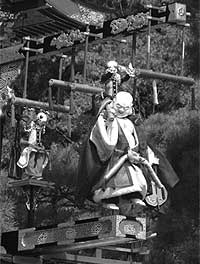
Karakuri puppet (Photo presented by Takayama City)

Nisshin-maru No.3 (Photo by Mineo Takagi)
What Is Intended by Hunting Prohibition

Professor, Waseda University
Every night, I make it a habit to busy myself with cataloging my insect collection, with a cup of sake in my hand. I am not actually pressed with this work because, unlike in the case of article contribution, there is no deadline. But I feel somehow pressed. I have such an enormous amount of specimens that I may not be able to set in order during the rest of my life.
Insect specimens will be of no use as research materials unless they are pinned, one by one, with a label attached to each. Although I do not care if these specimens may or may not serve any particular purpose, I cannot tolerate the idea of leaving all the insects I have collected to go rotten. Thanks to popularization of the strangely thwarted ideology of "conservation of nature," we cannot collect insects freely in forests because the forests where you can find insects are designated as reserves in every country. On the other hand, well-paved asphalt roads are built in those forests, causing the number of insects to decrease rapidly.
Perhaps, the important thing is not protecting insects but pretending to protect them. Construction of dams, cutting of forests and aerial sprinkling of insecticides certainly decrease the number of insects. However, no species of insects would decrease by catching them with nets only. However I complain, there is no way to contend against public opinion. The trend to prohibit bug hunting is spreading. We cannot identify the accurate name of a certain insect unless we collect it, make a specimen and examine it with a microscope. There are a number of insects having no names among the specimens I have collected myself. They may be what we call new species.
Most of the insects which I store in a refrigerator were collected in the primeval forests in Southeast Asia, and some might have gone extinct without being given a name. I am even tempted to suspect that such random prohibition of insect collecting is aimed at concealing such facts. Even when prohibition is in place, no one takes the responsibility of surveying the insects. The prohibition only makes a "black box" and we may be unable to determine what kinds of insects actually exist.
In Japan as well, as compared to other places, very little is known about the entomofauna in such places as Kamikochi in Nagano Prefecture and Daisetsuzan in Hokkaido, where insect collecting has long been prohibited. It is clear that insects near extinction cannot be protected unless the state of the increase or depletion of the entomofauna is monitored. So I guess that the authorities have no willingness to protect the insects. Even if precious insect species go extinct because of negligence of the government, they could blame the extinction on poaching by insect maniacs. The not so intelligent mass media, such as the Asahi Shimbun, seem to take a special interest in such topics as the extinction of valuable insects due to poaching by inconsiderate buffs. They are staging campaigns from time to time, giving a helping hand to the irresponsible government. Because diverse complex factors are involved in the state of a certain species, it is not so simple as to say that if you collect insects, they will decrease.
But demonizing insect lovers is a simple and easily understandable way to convince the public, as was the propaganda by the Nazis. This is the same as the case where ordinary people readily believe that whales are on the brink of extinction because the Japanese catch them.
As a matter of fact, the predominant part of entomofaunas in Japan has been clarified by amateur researchers. Amateurs have examined the entomofauna of a certain region at their own cost over a span of some decades and made lists of insect species. Using their study results, the government prohibits the catch of those species on the ground that they are rare. Thus the government shuts out amateur researchers from their research domain. I think this is an unreasonable approach.
Certainly there exist insects threatened with extinction. Those insects were driven to the risk of extinction because their ecological niche was deprived because of drastic changes in the environment. Therefore, extinction is inevitable if no conservation measures are taken while only prohibiting bug collection. There will remain only a few specimens after extinction. Many of the insects for which extinction is feared in Japan now are butterflies in the highlands, mountains and forests closely linked to human living environments. The only way to save them from extinction is to make positive efforts to increase the environment friendly to those butterflies. I am not necessarily opposed to the prohibition of bug hunting as an emergency measure. But I believe the appropriate protection is to lift the prohibition when the crisis is overcome after artificially increasing the butterfly population and realizing a suitable environment for them to live.
Catch prohibition is only one means of protection and not the purpose. Japanese serows are designated as a precious animal. But they were designated so because they were rare. The designation should be removed if they start causing a nuisance after growing to an excessive number. Cheirotonus jambar, the largest beetle in Japan, is designated as a precious insect and it is actually facing the risk of imminent extinction. The breeding technique for Cheirotonus by Japanese amateur entomologists is at the world's highest level. If several couples of this species are caught and bred artificially, they will certainly increase by the order of hundreds in several years. Nevertheless, I hear that the Cultural Agency, the office governing precious natural species, is taking the policy of not allowing the catch of even a single insect of this species. If the agency sticks to this policy, it will be inevitable that the case of the Japanese crested ibis will be repeated.
The coexistence with wildlife must not mean the total prohibition of catch. If this step is taken, man would not be able to eat any fish nor exterminate harmful insects. I believe that true coexistence can be ensured through proper utilization and management within the scope of sustainability. Whether they be insects or whales, man may not know how to deal with them if scientific research is not carried out. For this very reason, the fundamentalists want to make the prohibition of catch or collection as their golden rule. They never lose in argument if there are no data.
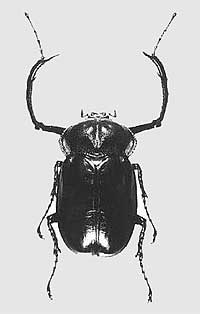
Alaska Native, Eskimo Whaling
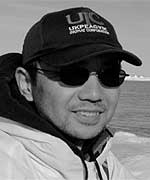
Photographer
In April, when ice covering the sea surface shows cracks, bowhead whales start their northward migration along the open sea channels toward the Arctic Ocean where abundant feed is found.
I was in Point Hope, an Eskimo town protruding into the Chukchi Sea, which is part of the Arctic Ocean off Alaska.
This is one of the oldest native settlements on the American continent. The settlement was originally developed for the bowhead whale hunting. The proximity of the settlement to the open water enabled the people access to the whales. A friend in Point Hope said proudly that his town has a longer history than that of Egypt.
At the ice edge, some whaling teams were already waiting for whales by preparing the Umiaq, a rowboat made from the skin of bearded seals.
We towed our Umiaq by a snow machine down to the ice edge and attached a bomb to the harpoon, making ourselves ready to chase a whale at any time.
The harpoons used here are the same type as those used during the sailboat-whaling period over 100 years ago, although they now use bomb. The harpoons thrown into the whale by human's own hand.
Men waited on the ice for the whales to approach. Some stood higher spots of the ice and watched eastward whence the whales may come. Others were taking a nap on the sled or drinking coffee comfortably.
Only chunk of ice flow from time to time and no whale appeared. I remembered the words often repeated to me: "Hunting by the Eskimo is to wait with patience." And I think that those words are true.
While I was dozing, someone whispered into my ear that we were taking out the boat. At last a whale had come into our sight.
In a tense atmosphere, which made me inattentive of the cold, a Umiaq was slid into the sea. Crews paddled the boat into the icy water. The only sound we could hear was the sound of paddles and waves. It was a quiet but intense chase.
A whale surfaced where we could not predict and each time the Umiaq changed its direction and continued the chase. But the whale swam into the wide open water and was lost.
After repeating several chases, one team finally caught a whale a bowhead over 15 meters long.
On the news that a whale was caught, people gathered and pulled the animal onto the ice taking several hours, using a thick rope with a huge pulley attached.
Flensing started when men having big knives and hooks with long handles gathered around the whale.
"Muktuk" (skin) with blubber is removed by thrusting the blades of the knives into the huge meat mass. Crimson-colored blood spouted out with white steam, probably because the whale's peritoneum was broken.
The whale, which was black-colored at the beginning, turned into a mass of red meat as its skin was peeled. The work continued without pause, and large blocks of meat were carved from the huge red mass.
Women came from the town and prepared a warm meal and coffee for the men. The men rested temporarily there and then returned to work.
I helped with the flensing using a knife and a hook. The huge body of the whale was fully stuffed with meat and viscera. It was a matter of course but I was really amazed by the scene.
After carving out some meat, a rope was attached to the viscera, it's pulled out on the ice. The viscera were scattered randomly on the ice, and I could not tell which part was which. But women skillfully pulled out the intestines and cut them into pieces of some tens of inches. These of course are used as food.
Men were cutting the skin of the liver in a round form to use it as material for large Eskimo drums.
The flensing of the whale, caught shortly after noon on the previous day, was completed by around 7 the next morning. The remaining head bone was thrown into the sea with a wish for the whale's return.
People should have been exhausted by the all-night work, but I could see smiles in their faces. I was also a smiling during the work, although I didn't realize it until I was told so.
In mid-June, the "Qagroq" feast takes place to celebrate the successful whaling for the year. The feast, joined by all the townsfolk, lasts for three days.
On the first day of the feast, "Mikiaq"--a mixture of fermented whale skin, blubber, meat and blood--was given out to the people who gathered at the feast. On the second day, "Avarraq," sliced tail fin, was served.
On the third day, all the parts of the whale--the heart, intestines and other viscera such as the kidneys, were boiled and served to the people. Also Muktuk and meat were given. Besides whale meat, I could see various kinds of wildlife meat, such as Beluga, bearded seals, walrus and caribou.
Seeing the happy smiling faces of people eating whale and other wildlife meat during the feast, I came to know how the traditional diet is important to them.
Although Point Hope people usually eat hamburgers and sandwiches, they cannot abandon traditional foods so easily. It is the same as the situation in Japan that we never abandon miso (bean paste) soup and natto (fermented soybeans) even when we accepted the Western lifestyle.
Many people criticize the U.S. anti-whaling position as a "double standard." However, please keep in your mind that the Eskimo have hunted whales and used them as an important food from time immemorial to the present day.
¥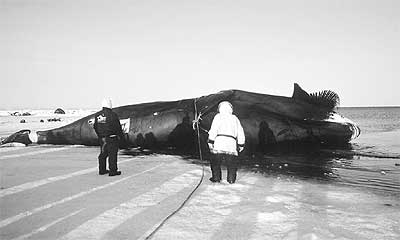
Umiaq chasing a whale
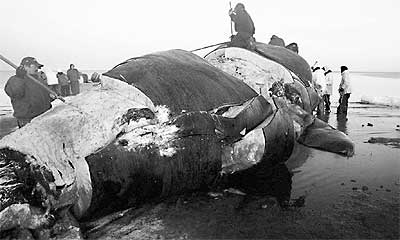
Flensing of a bowhead whale
(Photos presented by the author)
